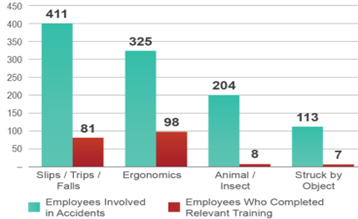Share This Article:

Putting the United States Postal Service Under the Microscope: A Thorough Workers’ Compensation Claims Analysis
08 Feb, 2024 Connor Thomson Robert Stickley

by Robert S. Stickley, Esq. and Connor J. Thomson, CPCU, CAWC
Introduction
When you put the United States Postal Service (USPS) under the microscope, not only do you learn about Newman’s disdain for the mail, but you also get a great case study for high-risk self-insureds in the private industry. As the USPS grapples with internal lapses in safety and health training and changes in mail mix, its approach to risk management and workplace safety becomes a cautionary tale.
An Overview of the USPS’s Workers’ Compensation Program
The USPS has 516,750 career employees and 118,600 non-career employees.[1] All 635,350 USPS employees are covered under the Federal Employees’ Compensation Act (FECA).[2] The FECA was established on September 7, 1916, to offer federal employees the same benefits that were offered to state employees.[3] Today, the FECA offers all 635,350 USPS employees the following benefits: wage-loss compensation, medical services, rehabilitation services, and death benefit payments.[4]
The United States Department of Labor’s Office of Workers’ Compensation Programs (DOL OWCP) has the exclusive authority to administer, implement, and enforce the FECA.[5] In 2022, the DOL OWCP processed over 182,000 new workers’ compensation claims and provided over 179,000 injured federal employees with $2.92 billion in benefits.[6] That year, USPS employees accounted for forty-two percent of the $2.92 billion in benefits.[7] Using $1.22 billion as a comparative financial, the USPS Office of Inspector General (USPS OIG) concluded that the USPS’s workers’ compensation costs per workhour were thirty-one to forty-one percent greater than the private industry’s between 2017 and 2022.[8]
The USPS reimburses the DOL OWCP for incurred administrative fees through a process called “chargeback billing.”[9] In 2022, the USPS incurred, and reimbursed the DOL OWCP for, $89.39 million in administrative fees—forty-eight percent of all administrative fees billed to federal agencies that year.[10]
The USPS conceded that “workers’ compensation insurance and claims expenses . . . have a material adverse effect on [its] business, financial condition[,] and results of operations.”[11]
The Good, the Bad, and the Ugly
The reality of the USPS’s workers’ compensation program is that letter carriers are subjected to dog bites;[12] repetitive motion injuries; slips, trips, and falls; auto accidents; and paper cuts more frequently and for a longer duration than non-letter carrier USPS employees and the general public. Because letter carriers’ primary job tasks include casing, transporting, and delivering mail, the nature of their job positions them at an increased risk of injury. In fact, letter carriers were involved in 209,393 of the USPS’s 299,198 total industrial accidents between 2017 and 2021.[13]
The Good
The USPS considers employee safety and health to be a top priority, and its philosophy is that (1) industrial accidents are predictable and avoidable events; (2) all injuries are preventable; and (3) safety and health training never ends.[14]
The USPS experienced a drop in industrial accidents between 2017 and 2020.[15] In 2017, the USPS experienced about 65,000 industrial accidents compared to about 55,000 in 2020.[16] Excluding coronavirus claims, the USPS’s overall number of workers’ compensation claims has trended downward since 2017, reaching a low of 40,448 in 2022.[17]
The overall number of USPS employees on the periodic roll has trended downward since 2017, too.[18] USPS employees on the periodic roll have a disability that is expected to last for more than ninety days or be permanent.[19] In 2017, 15,525 USPS employees were on the periodic roll compared to 14,932 in 2022.[20]
By administratively returning 593 employees to work, the USPS embraced a recovery mindset, which enabled those 593 employees to rediscover meaning, purpose, and community in modified work.
When an employer has a return-to-work program, it takes 5.1 weeks and costs $2,805 for an injured employee to reach maximum medical improvement. When an employer does not have a return-to-work program, it takes thirteen weeks and costs $7,150 for an injured employee to reach maximum medical improvement.
The Bad
Ironically, while the USPS considers employee safety and health to be a top priority, and while the USPS appears to be fanatical about safety and health, facility-level management has failed to administer proper safety and health training.[21] The USPS OIG estimated that fifty-four percent of the USPS’s 299,198 total industrial accidents between 2017 and 2021 could have been prevented by proper safety and health training.[22] The image below displays the relationship between USPS employees involved in industrial accidents between 2017 and 2021 and USPS employees who completed safety and health training between 2017 and 2021:

Mitigating humanitarian harm can be achieved through teaching and instruction. While seemingly straightforward, teaching and instruction is often overlooked as a valuable risk management tool. If facility-level management does its job of administering proper safety and health training, USPS employees will be empowered with the knowledge and skills necessary to prevent industrial accidents and minimize the impact of work-related injuries.
The Ugly
The changes in mail mix and its effects on the USPS’s workforce are problematic.[23] Pronounced by the coronavirus pandemic, the USPS’s package volume surged one-hundred-and-sixty percent between 2009 and 2021.[24] Home package delivery—especially home package delivery of overweight packages[25]—increased, while first-class mail delivery shrunk by thirty-nine percent between 2009 and 2021.[26]
As package volume and weight increases, so does the chance that a letter carrier will suffer a work-related injury.[27] In fact, the USPS OIG statistically concluded that a letter carrier is 4.4 percent more likely to suffer a work-related injury if it delivers two-thousand pounds per quarter.[28]
In 2021, each letter carrier delivered an average of sixty-one packages per day—a twenty-four percent increase from 2019.[29] Also in 2021, each letter carrier delivered an average of 12,700 pounds per quarter.[30] Using the USPS OIG’s statistical conclusion, in 2021, each letter carrier was over 26.4 percent more likely to suffer a work-related injury.[31]
Consequently, it is unsurprising that letter carriers represent fifty-two percent of all USPS employees but are responsible for seventy-one percent of the USPS’s wage-loss compensation and medical services benefits.[32]
For more information on this topic, please contact Robert S. Stickley, Esq. at rstickley@stickley.law or Connor J. Thomson, CPCU, CAWC at cthomson@stickley.law.
[1] Postal Facts, United States Postal Service, https://facts.usps.com/ (last visited Jan. 12, 2024).
[2] Federal Employees’ Compensation Act, Pub. L. No. 93–416, § 2, 88 Stat. 1143 (codified at 5 U.S.C.S. §§ 8101–8193).
[3] United States Postal Service Office of Inspector General, Workers’ Compensation Program Update 3 (2023), https://www.uspsoig.gov/reports/audit-reports/workers-compensation-program-update.
[4] Id.
[5] Id.
[6] Id. at 4.
[7] Id. That year, the USPS’s workers’ compensation costs were $1.22 billion ($2.92 billion x 0.42 = $1.22 billion).
[8] Id. at 6. It is important to compare the USPS’s workers’ compensation costs per workhour to the private industry’s because, in the private industry, workers’ compensation is a profit engine, not a cost center.
[9] Id. at 4. Chargeback billing occurs when the DOL OWCP bills federal agencies for their “fair share” of workers’ compensation costs, which are calculated by payments made from the Employees’ Compensation Fund. The DOL OWCP has statutory authority pursuant to 5 U.S.C.S. § 8147.
[10] Id.
[11] United States Postal Service, 2023 Report on Form 10-K 14 (2023), https://about.usps.com/what/financials/ 10k-reports/fy2023.pdf.
[12] Briana Zamora-Nipper, USPS: Houston top city for mail carrier dog attacks, Click2Houston (June 5, 2023, 9:24 AM), https://www.click2houston.com/news/local/2023/06/05/usps-houston-top-city-for-mail-carrier-dog-attacks/. In 2022, over 5,300 letter carriers were subjected to dog bites, with the most attacks coming from Houston, Texas (fifty-seven). Second place was Los Angeles, California (forty-eight), and third place was Dallas, Texas (forty-four).
[13] United States Postal Service Office of Inspector General, Safety and Health Program Training 3 (2023), https://www.uspsoig.gov/reports/audit-reports/safety-and-health-program-training.
[14] Id. This philosophy is promising because it appears that the USPS is fanatical about safety and health.
[15] Id. at 5.
[16] Id.
[17] United States Postal Service Office of Inspector General, Workers’ Compensation Program Update 5 (2023), https://www.uspsoig.gov/reports/audit-reports/workers-compensation-program-update.
[18] Id. at 10.
[19] Id.
[20] Id.
[21] United States Postal Service Office of Inspector General, Safety and Health Program Training 5–6 (2023), https://www.uspsoig.gov/reports/audit-reports/safety-and-health-program-training. According to “Employee and Labor Relations Manual, Issue 52 – Chapter 8 Safety and Health Environment,” facility-level management is responsible for administering property safety and health training.
[22] Id. at 4.
[23] United States Postal Service Office of Inspector General, Changes in Mail Mix: Implications for Carriers’ Physical Health 3 (2022), https://www.uspsoig.gov/reports/white-papers/changes-mail-mix-implications-carriers-physical-health. “Mail mix” is defined as the combination of mail classes and products the USPS processes through its delivery network.
[24] Id.
[25] The number of packages weighing over seventy pounds increased by eighty-six percent between 2020 and 2022.
[26] United States Postal Service Office of Inspector General, Changes in Mail Mix: Implications for Carriers’ Physical Health 5 (2022), https://www.uspsoig.gov/reports/white-papers/changes-mail-mix-implications-carriers-physical-health.
[27] Id. at 8.
[28] Id.
[29] Id. at 3.
[30] Id. at 6.
[31] See id. at 8.
[32] Id. at 11.
AI california case file case management case management focus claims compensability compliance courts covid do you know the rule exclusive remedy florida FMLA glossary check health care Healthcare hr homeroom insurance iowa leadership leadership link medical NCCI new jersey new york ohio osha pennsylvania roadmap Safety safety at work state info technology texas violence WDYT what do you think women's history women's history month workcompcollege workers' comp 101 workers' recovery Workplace Safety Workplace Violence
Read Also
About The Author
About The Author
- Connor Thomson Robert Stickley
More by This Author
Read More
- Jun 30, 2025
- Cameron Hannum
- Jun 30, 2025
- Kristin Green
- Jun 30, 2025
- Natalie Torres
- Jun 26, 2025
- NCCI
- Jun 24, 2025
- Heather Schwartz Sanderson
- Jun 21, 2025
- Edward Stern




